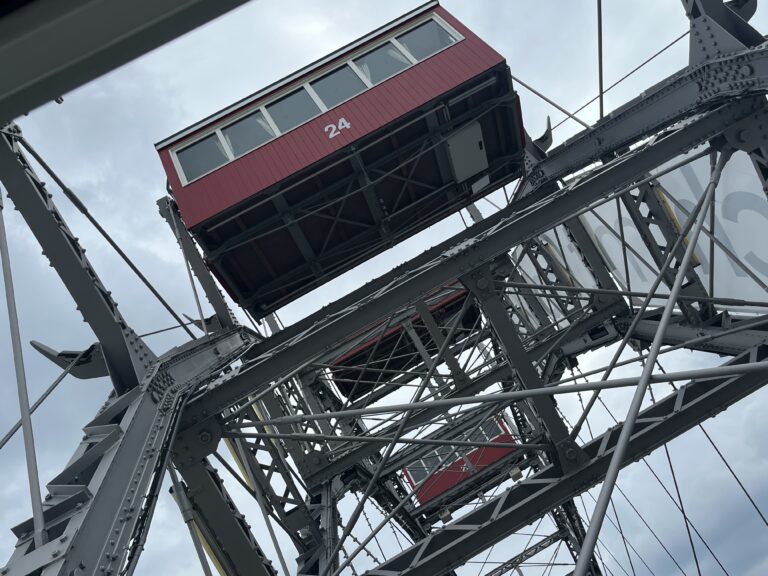What is the greatest British film ever made? My vote—and the vote of the British Film Institute—goes to Carol Reed’s cynical, sinister film noir The Third Man, which this year marks its 75th birthday.
This is why I’ve headed to Vienna, to celebrate the milestone by revisiting the 1949 film and the city where it’s set. Of course, after it had been bombed in WWII, the Austrian capital had nothing like the pristine magnificence of today. Yet its air of devastation, amid that grandeur, inspired the film’s stunning black-and-white camerawork, which earned it an Oscar.
If you haven’t seen The Third Man, incidentally, you really should, as it’s a knock-out. It boasts a string of star turns, including a scenery-chomping Orson Welles, and the lovely Alida Valli as his long-suffering girlfriend. There’s also a witty, weary script by the novelist Graham Greene. Literary credentials in the movie business don’t get better than that.
So here is my tasting menu of five unforgettable scenes—and how you can pay tribute to them in today’s Vienna.
Scene 1: The Opening Credits
The viewer sees the plucked strings of a zither (a kind of cross between a lyre and a ukulele) reverberate, as it plays the jaunty theme tune by Anton Karas. The illiterate musician was talent-spotted by the director Carol Reed in a Viennese cafe and catapulted to stardom when his little melody topped the charts around the world.
My wife Georgia and I visit the Third Man Museum, which is surely the world’s greatest museum devoted to a single movie. Put together with a crazed devotion by super-fan Gerhard Strassgschwandtner, this collection of more than 3,000 items includes Karas’s original zither. There are film posters from all over the world; the shooting script of Trevor Howard (who plays the police chief Calloway); and even a black marble gravestone that features in the film, which Gerhard bought after its owners neglected its upkeep at the Central Cemetery.
Scene 2: First Sight of Harry Lime
Holly Martins (Joseph Cotton) arrives in Vienna to visit his friend Harry Lime (Welles), only to learn he has died in an accident. Or has he? A few days later, Martins spots the black shoes of a man hidden in a doorway. Then a light from across the street falls on him, revealing the smirking, corrupt-cherub features of Lime himself. The critic Roger Ebert said that this moment inspired him to devote his life to the movies.
Georgia and I rewatch the film at the Burg Kino Cinema, where it plays three times a week. Seeing it in Austria is fun, because one’s fellow viewers get the jokes by the occasional German-speaking characters, even if we don’t. Afterwards, Gerhard steers us to three key shooting locations, including that doorway where Lime is first glimpsed.
Scene 3: The Ferris Wheel
At the top of the Riesenrad (Big Wheel) in the Prater fun park, Martins challenges Lime about his villainy. (He is selling diluted penicillin, causing horrific suffering and death.) Lime points out tiny figures far below and asks how much Martins would care if a few stopped moving. Then, in a piece of dialogue improvised by Welles (who stole it from the painter James Whistler), he remarks that corrupt Italy produced the Renaissance, while peaceful Switzerland has made only one contribution to culture: the cuckoo clock.
When Georgia and I reach the top of the Wheel, neither of us threatens to kill each other, as happens in the film. We simply enjoy the old-fashioned wooden cabin, and admire, from our vantage point 65m up, the city’s splendid spires and rooftops.
Scene 4. Trapped in the Sewers
Fleeing the police, Lime takes refuge in the labyrinth of sewers under the city. As in a nightmare, he stumbles, desperate and disoriented, pursued by torches and guns.
Georgia and I join one of the regular tours of these sewers run by Vienna’s state sewage company. We descend through the same entrance in Karlsplatz used by Lime. And the smell is terrible. Oh boy. Georgia dabs perfume under my nose, which helps. But soon after, she bails. I soldier on, breathing through my mouth, but unable to avoid peering into the effluent. Many of the sewer scenes were shot down here, our guide reveals, but Welles refused to stoop so low, meaning his close-up shots had to be done in a studio. Also it was hard to find a suitable body double for the actor, since he was rather rotund, and in those days most people in Vienna were thin from postwar rationing.
Scene 5. The Cemetery Walk
It’s one of the great final scenes in cinema history. After helping the police in their pursuit of Lime, Martins waits for Anna (Valli) at the end of a long avenue at Vienna’s Central Cemetery. He knows Anna loved Lime and can’t love him, but still he hopes—and we hope too. But she walks right past him and keeps going, leaving poor old Martins lighting a disconsolate cigarette.
We visit this wonderful cemetery—the second largest in the world, after one in Hamburg—and admire the graves of Beethoven, Strauss and Schubert. Then Georgia and I recreate that scene. Having no rustic cart like Martins in the film, I lean on a wheelie bin and we get the shot.
With all respect to Gerhard Strassgschwandtner, there are other reasons to visit Vienna than an obsessive interest in The Third Man. Georgia and I find time to admire the incredible big square Klimt landscapes at the Belvedere Museum, to eat well at the new Cafe Englander by the Prater, and to sample cocktails at the bar of our excellent berth at the Hotel Beethoven. But I must admit that, watching the film in the city where it was shot, and infected by Gerhard’s passion, I’m now surer than ever that it deserves its reputation.

